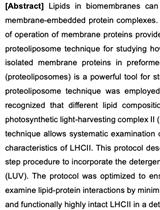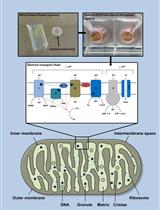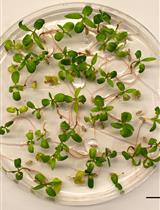- EN - English
- CN - 中文
Expression and Purification of Arabidopsis Transmembrane Protein BCM1 in Saccharomyces cerevisiae
拟南芥跨膜蛋白BCM1在酿酒酵母中的表达与纯化
发布: 2020年09月20日第10卷第18期 DOI: 10.21769/BioProtoc.3758 浏览次数: 4639
评审: ANSUL LOKDARSHIRunlai HangAnonymous reviewer(s)
Abstract
Heterologous expression and purification of transmembrane proteins have remained a challenge for decades hampering detailed biochemical and structural characterization of key enzymes and their interacting regulators in multiple metabolic pathways. An in-depth study on the newly identified Arabidopsis thaliana integral membrane protein BALANCE OF CHLOROPHYLL METABOLISM 1 (BCM1) showed a stimulatory effect of the BCM1 on magnesium chelatase, the first enzyme of chlorophyll biosynthesis, through interaction with the GENOMES UNCOUPLED 4 (Wang et al., 2020). Here, we report a detailed and optimized method for heterologous expression and purification of His-tagged BCM1 in Saccharomyces cerevisiae. Following this method, we obtained native BCM1 used for in vitro enzymatic assay of magnesium chelatase (Wang et al., 2020). Currently, the crystallization studies of the BCM1 are underway. This protocol could be adapted to purify BCM1-like transmembrane proteins from eukaryotic organisms for enzymatic and structural studies.
Keywords: A transmembrane protein (跨膜蛋白)Background
Identification of post-translational regulators which directly modulate the enzymatic activities of chlorophyll synthesis enzymes can greatly improve our understanding of molecular mechanisms, by which plants maintain highly efficient chlorophyll biosynthesis during leaf greening (Brzezowski et al., 2015). However, the detailed biochemical analyses of chlorophyll synthesis enzymes and their interacting proteins have been restricted by the availability of recombinant proteins in vitro. We recently identified a post-translational regulator BALANCE OF CHLOROPHYLL METABOLISM 1 (BCM1), which simultaneously stimulates chlorophyll biosynthesis and delays chlorophyll breakdown, thereby conferring chlorophyll homeostasis during leaf development (Wang et al., 2020). To examine BCM1’s effect on the enzymatic activity of magnesium chelatase (MgCh), the first enzyme of chlorophyll biosynthesis, we expressed and purified His-tagged BCM1 in S. cerevisiae. It has been shown that BCM1 is able to stimulate MgCh activity in vitro (Wang et al., 2020). Because BCM1 has six transmembrane domains, BCM1 will be used an example of multiple-pass protein herein. Thus, we provide an optimized method for expression and purification of BCM1 in S. cerevisiae. Although prokaryotic purification system hosted by Escherichia coli has been widely used to express hydrophilic proteins from prokaryotic and eukaryotic organisms, overexpression of BCM1 in Escherichia coli cells leads to accumulation of BCM1 aggregate and inclusion bodies instead of properly folded proteins at the membranes. In comparison with cell-free protein expression systems and other eukaryotic expression systems, such as mammalian and insect expression systems, the yeast protein expression method described here enables a large-scale purification of integral membrane proteins with high yield and low cost.
Materials and Reagents
- Sterile pipette tips
- Eppendorf microcentrifuge tubes 1.5 ml (Eppendorf, catalog number: 00 30121694 )
- Falcon, conical centrifuge tubes 50 ml (Corning, catalog number: 14-432-22 )
- 0.45 μm filter (VWR, catalog number: 28145-479 )
- 14 ml Open-top thinwall untra-clear centrifuge tube (Beckman Coulter, catalog number: 344060 )
- Dispensable plastic spin column (Thermo Fisher Scientific, catalog number: 10220544 )
- SnakeSkin Dialysis Tubing 10 kDa cut-off (Thermo Fisher Scientific, catalog number: 68100 )
- Saccharomyces cerevisiae L40ccua strain
- pDR296-His-BCM1 plasmid
- Salmon sperm (Thermo Fisher Scientific, catalog number: 15632011 )
- Demineralized water
- Bacto yeast extract (Cal Roth, catalog number: 2904 )
- Bacto peptone (Cal Roth, catalog number: 8952 )
- Glucose monohydrate (Cal Roth, catalog number: 6780 )
- Adenine sulfate (Sigma-Aldrich, catalog number: A3159 )
- Agar-Y (MP Biomedicals, catalog number: 4019012 )
- Yeast nitrogen base (YNB) with ammonium sulfate (MP Biomedicals, catalog number: 4027412 )
- Synthetic dropout/-tryptophan (SD/-Trp) (MP Biomedicals, catalog number: 4511012 )
- Glycerol (Sigma-Aldrich, catalog number: G5516 )
- n-dodecyl-β-D-maltoside (β-DM) (Sigma-Aldrich, catalog number: D4641 )
- Ethylenediaminetetraacetic acid disodium salt dihydrate (EDTA·Na2) (Sigma-Aldrich, catalog number: ED2SS )
- Tris(hydroxymethyl)aminomethane (Tris) (Cal Roth, catalog number: A411 )
- Hydrochloric acid (HCl) (VWR, catalog number: BDH7204 )
- Sodium hydroxide (NaOH) (Fisher Scientific, catalog number: BP359-212 )
- Lithium acetate (LiAc) (Cal Roth, catalog number: 5447 )
- Polyethylene glycol 4000 (PEG4000) (Sigma-Aldrich, catalog number: 8.0749 0)
- Liquid nitrogen
- cOmplete, mini, EDTA-free protease inhibitor tablets (Roche Diagnostics, catalog number: 11873580001 )
- Glass beads (425-600 μm) (Sigma-Aldrich, catalog number: G8772 )
- Sodium chloride (NaCl) (Cal Roth, catalog number: 9265 )
- Potassium chloride (KCl) (Cal Roth, catalog number: 6781 )
- Sodium phosphate monobasic dihydrate (NaH2PO4·2H2O) (Cal Roth, catalog number: T879 )
- Potassium dihydrogen phosphate (KH2PO4) (Cal Roth, catalog number: 3904 )
- Ni-NTA agarose resin (Thermo Fisher Scientific, catalog number: 88223 )
- Imidazole (Sigma-Aldrich, catalog number: I2399 )
- YPD medium (930 ml) (see Recipes)
- 40% (w/v) glucose (100 ml) (see Recipes)
- 0.2% (w/v) Adenine sulfate (see Recipes)
- YPDA medium (1 L) (see Recipes)
- SD/-Trp medium (1 L) (see Recipes)
- 80% (v/v) glycerol (100 ml) (see Recipes)
- 10x Tris-EDTA (TE) buffer (200 ml) (see Recipes)
- 1 M LiAc (200 ml) (see Recipes)
- 50% (w/v) PEG4000 (100 ml) (see Recipes)
- 10x phosphate-buffered saline (PBS) buffer (1 L) (see Recipes)
- 10% (w/v) β-DM (see Recipes)
- 1x TE buffer (see Recipes)
- TE/LiAc buffer (see Recipes)
- Polyethylene glycol (PEG)/LiAc buffer (see Recipes)
- Solubilization buffer (10 ml) containing 1% (w/v) β-DM (see Recipes)
- Wash buffer containing 0.0256% (w/v) β-DM and 20 mM imidazole (20 ml) (see Recipes)
- Elute buffer containing 0.0256% (w/v) β-DM (see Recipes)
- Dialysis buffer (1 L) containing 0.0256% (w/v) β-DM (see Recipes)
Equipment
- Glassware
250 ml Erlenmeyer flask
200 ml Erlenmeyer flask
2 L Erlenmeyer flask
1 L Erlenmeyer flask
100 ml Erlenmeyer flask
1 L transparent glass media bottle
250 ml transparent glass media bottle
100 ml transparent glass media bottle - Rotor JA-25.50
- Rotor FA-48-45-11
- Milli-Q Reference Water Purification System (EMD Millipore, catalog number: Z00QSV0WW )
- Clean bench (Labconco, model: 3440009 )
- Water bath
- Temperature controlled shaker incubator
- Vortex mixer (Scientific Industries, model: Vortex-Genie 2 )
- Cold room
- Deep freezer (-20 °C)
- Ultra-low temperature freezer (-80 °C)
- Centrifuge (Eppendorf, model: 5430 R )
- High speed centrifuge (Beckman Coulter, model: Avanti J-26XP )
- Ultracentrifuge (Beckman Coulter, model: Optima L-80 XP )
Procedure
文章信息
版权信息
© 2020 The Authors; exclusive licensee Bio-protocol LLC.
如何引用
Wang, P. and Grimm, B. (2020). Expression and Purification of Arabidopsis Transmembrane Protein BCM1 in Saccharomyces cerevisiae. Bio-protocol 10(18): e3758. DOI: 10.21769/BioProtoc.3758.
分类
植物科学 > 植物生理学 > 新陈代谢
生物化学 > 蛋白质 > 表达
您对这篇实验方法有问题吗?
在此处发布您的问题,我们将邀请本文作者来回答。同时,我们会将您的问题发布到Bio-protocol Exchange,以便寻求社区成员的帮助。
Share
Bluesky
X
Copy link













